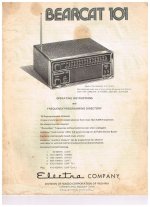- Joined
- Sep 7, 2020
- Messages
- 2,688
Living in the Bronx during the 1970’s, prior to getting on the job, I buffed fires. Looking back it is amazing how high tech buffing has become. All scanners were crystal controlled. You had to purchase a 5 dollar crystal for each frequency you wanted to listen to (typically from Radio Shack). Almost all handheld scanners only were able to monitor 4-8 frequencies. ( citywide, 4 Boros, handi talki, NYPD SOD, and local NYPD division where I lived ). Mobile scanner like the “Sonar Brand” and some of the “realistic” brand had as many as 12-16 frequencies that could be monitored. Some of the super buffs had 2-4 mobile scanners in their cars with 2-4 antennas on the trunk. The only way to find your way to jobs - especially in unfamiliar sections of the city was to carry a book which listed all the box numbers and locations and a Hagstrom map of each boro. If you weren’t listening to the scanner or near your landline phone you missed jobs. Cameras - 35mm with rolls of 24 or 36 exposures. You had to plan your shots carefully and use the limited number wisely. Then you had to wait 2-3 days for the film to be developed. Share photos with someone. You had to take the negatives back to the photo store and pay to have copies or 8x 10
Enlargements
Flash forward to today. All data is retrievable in an instant via your own personal computer - your smartphone. You can receive notifications as the runs are being dispatched. Sites such as this provide the run downs of units responding. You can look up box locations, firehouses, etc instantly from anywhere. Heck you can even instantly pull up a photo of the fire building via apps such as google street view. To get there , your smartphone gives you turn by turn directions - no physical maps! A GPS in the car is even nicer. Scanners? For decades now the digital scanners have permitted users to program 100’s and even 1000’s and frequencies / talk groups into the device , you don’t even need to buy a scanner. Mobile scanner apps are available. Cameras? Once again your smart phone is your camera allowing almost unlimited shots and allowing you to instantly post stills and videos to on line sites, social media and share with friends or the members that were operating on scene. The ability to instantly text messages, notifications and photos, videos is truly amazing.
Sadly though there are always those that ruin it for everyone. During civil disturbances in NYC two years ago, shitheads were jamming NYPD frequencies with $100 cheap Chinese radios. When a cop is shot or a member of our job is killed or injured, the news media and shithead social media idiots rush to find out and post the members company number or even his name - before family can even be notified. Terrorists and anarchists listen to police and fire tactics and procedures for there own nefarious reasons This has resulted in the gradual shift to encryption. All of the UK is encrypted. Many cities are going encrypted as they upgrade there radio systems.
looking back - a stark contrast on buffing 40 years ago as compared to today. As us older guys like to say “ you young guys have it so easy today” LOL. Stay safe.
Enlargements
Flash forward to today. All data is retrievable in an instant via your own personal computer - your smartphone. You can receive notifications as the runs are being dispatched. Sites such as this provide the run downs of units responding. You can look up box locations, firehouses, etc instantly from anywhere. Heck you can even instantly pull up a photo of the fire building via apps such as google street view. To get there , your smartphone gives you turn by turn directions - no physical maps! A GPS in the car is even nicer. Scanners? For decades now the digital scanners have permitted users to program 100’s and even 1000’s and frequencies / talk groups into the device , you don’t even need to buy a scanner. Mobile scanner apps are available. Cameras? Once again your smart phone is your camera allowing almost unlimited shots and allowing you to instantly post stills and videos to on line sites, social media and share with friends or the members that were operating on scene. The ability to instantly text messages, notifications and photos, videos is truly amazing.
Sadly though there are always those that ruin it for everyone. During civil disturbances in NYC two years ago, shitheads were jamming NYPD frequencies with $100 cheap Chinese radios. When a cop is shot or a member of our job is killed or injured, the news media and shithead social media idiots rush to find out and post the members company number or even his name - before family can even be notified. Terrorists and anarchists listen to police and fire tactics and procedures for there own nefarious reasons This has resulted in the gradual shift to encryption. All of the UK is encrypted. Many cities are going encrypted as they upgrade there radio systems.
looking back - a stark contrast on buffing 40 years ago as compared to today. As us older guys like to say “ you young guys have it so easy today” LOL. Stay safe.

